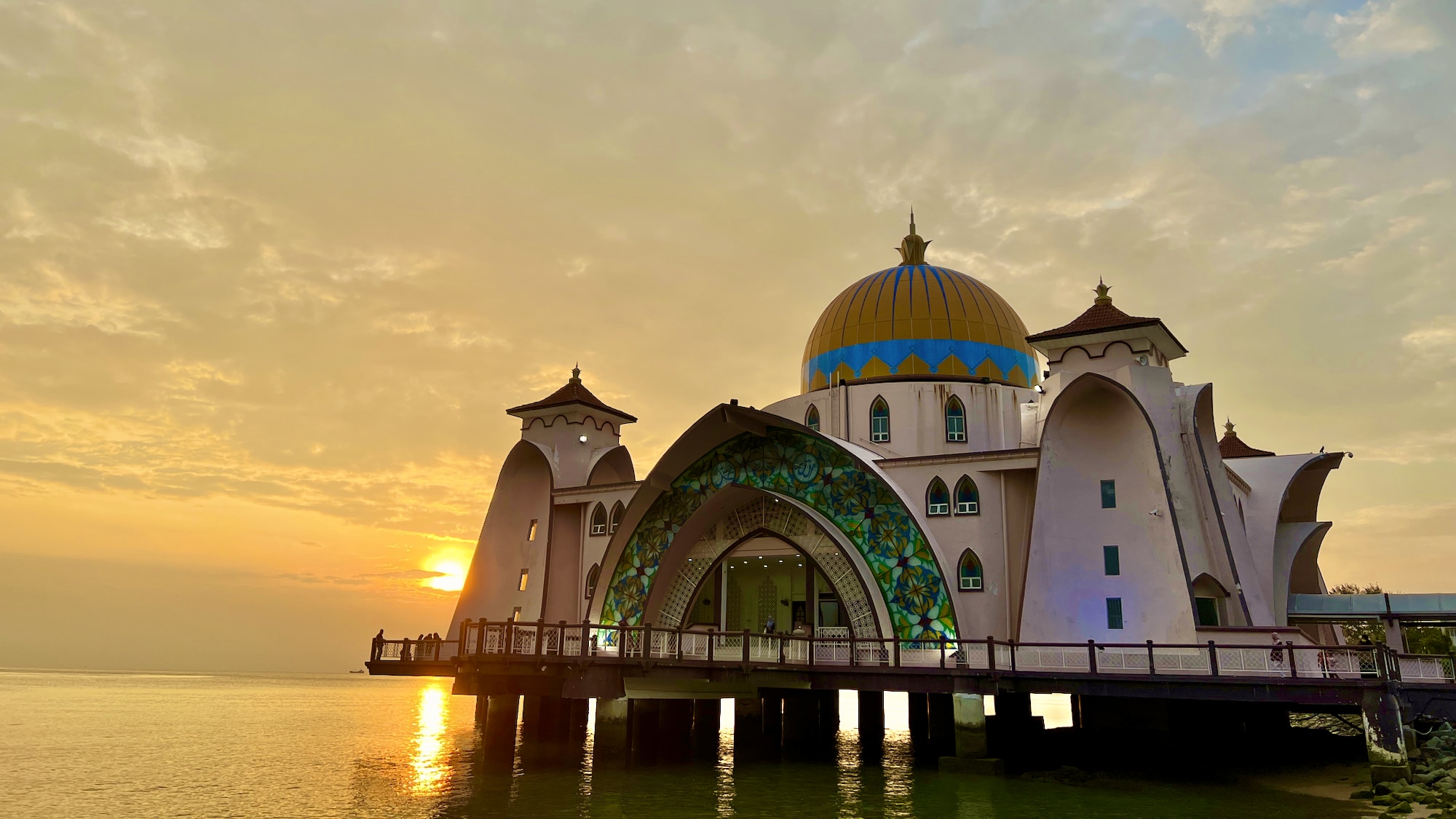Read Part 1 “Kuala Lumpur” here →
It took about two and a half hours to reach Melaka from the busy bus depot in southern Kuala Lumpur. We had loaded up on snacks and sandwiches for our lunchtime departure, just liking getting the “ekiben” or packed lunches in Japan before getting on the Shinkansen for a long journey. The bus was a long haul bus, very comfortable and the seats laid back far. The driver on the otherhand was anything but laid back. Before departure he stood at the front of the bus and delivered a strong lecture, outlining the rules on his bus, including NO EATING. For you see, this bus was his home. For obvious reasons he wanted to keep it clean. I was in the very first row behind the driver’s seat, and looked up. This explained the clotheshangers on the curtain rod above, where certain delicates were being aired out. We were guests in his home, and I was going to do my best to make a good impression. So even though I was starving I did not even sneak a bite of anything for the whole trip. I just set my body on low energy and watched the world slip by.
First was the southern edges of the city. Curving freeways, multi-lane on ramps and off ramps, the occasional cursing of the driver in Malaysian. A couple traffic jams later we were in different a traffic jam on the open highway (so many cars!). The highways looked like Japan with all the signage being similar shapes and colours, but it felt more like Canada since the land was open and with nothing but forest on either side of the road. Cruising along at high speed the rows and rows of trees slid by in a kaleidoscopic pattern. These are all palm oil tree farms, one of the cash crops of Malaysia. Massive palm trees lined up in neat rows for easy harvesting of the oil. In this, it was more like Japan than Canada.
Passing through a few regional communities we saw the typical characters of suburbs: strip malls and development tracts, some with big signs in Chinese characters. Malaysian development is not just limited to Kuala Lumpur and Johor Bahru. Later in Melaka we would see some large mainland China-backed developments that had been paused by Covid. These developments south of KL seemed more local, and I wondered if this was overflow from the big city which has had an overheated real estate market for a while now.
It was pouring rain when we finally pulled into the Melaka bus depot. Already we knew we were no longer in the tourist wonderland of central KL. But there was a Subway! We paused here to eat an overdue lunch, making the kids order by themselves to give them an opportunity of independence in a foreign country. They were really good the whole trip, able to stick close, take care of themselves, and be adventurous in eating (other than Subway of course!).
Grab is the big ride-sharing app in Malaysia, and we did use it a couple of times, but in Melaka we were able to take a little nostalgia trip and use the local taxi “cartel” at the bus depot. There were all these glorious older gentleman sitting around under an awning at one exit of the depot, BS-ing and laughing with one another like old friends. A little booth advertised the taxi ride downtown for a set price. We secured a ride with a smiling man who I swear was in his seventies. In recent years Melaka streets had been reorganized into a tangle of one way thoroughfares. Snarls of traffic meant if you missed your turn you had to take “the long way round.” Our happy driver chit-chatted with us as he cut through gas station parking lots and back alleys to avoid traffic.
The lamp posts along the street were large decorative keris (kris) knives. In fact, there is a tower in the shape of a keris in Melaka (see below video). I asked about the keris knives and the driver related to me a simplified version of the legend of Hang Tuah and his four warrior friends, a hero from the 15th century Malaccan sultanate. In fact, this main street we were on is called Jalan Hang Tuah. This kind of local history made me happy that we spent some of our time outside of Kuala Lumpur.
We were dropped off in front of our accommodations, the Swiss Heritage Hotel, which despite the name was one of the most Chinese-looking hotels I have ever stayed in. To add another oh-so-Malaysia twist, it turns out the hotel was build by the Dutch 300 years ago. This hotel was just two blocks from Jonker Walk, a major tourist street lined with shops. The street we stayed on was lined with old Baba-Nyonya mansions.
The Baba-Nyonya people are the descendants of the Southern Chinese that migrated to Malaysia in the 14th to 17th centuries. There is a lot of complexity and diversity in Straits Chinese communities that I don’t have the understanding to explain properly, so I will just share that here in Melaka the Baba-Nyonya culture is both celebrated and commodified. The Baba-Nyonya museum, a converted mansion of a wealthy family, was a fascinating introduction to local architecture. The house had open areas to let the rain in (natural cooling), both indoor and outdoor kitchens, gorgeously carved decorations, and a striking staircase with ingenious security system to keep intruders out of the second floor. We also enjoyed some of the distinct cuisine and sweets of the Baba-Nyonya.
This quarter of the city is a compact representation of the diverse history of Melaka and Malaysian all within a few blocks. Jonker Walk terminates at a roundabout where there are Dutch warehouses and a Methodist church surrounding a British fountain dedicated to Queen Victoria. There is a replica Portuguese galleon just two minute walk away. One street over from Jonker Walk is “Harmony Road” which features the oldest Chinese temple in Malaysia beside a very old mosque and an 18th century Hindu temple, all in a row!
For the days we spent in the heat of Melaka we wandered these streets experiencing an entirely different Malaysia than we had in KL. We enjoyed nasi lemak for breakfast, I drank coffee out of a bag, we ate all sorts of sweets, and enjoyed the blaring music of the gaudily decorated trishaws. During a laundry day I chatted with a man who ran a guesthouse (he had NewZies this week, and Aussies last). He was very interested in international politics and asked me my position on the war in Ukraine, but mostly he wanted to share the “Asian” position. Not a direct quote, but I wrote it down as soon as I could: “We Asians think Putin is doing the right thing. NATO should not be putting all those missiles next door. If someone moved next to you and tied 5 scary dogs to your fence, you would want to stop them too!”
I am really glad we made the last minute decision to come here, and it reinforced my interest in visiting other areas of Malaysia like Ipoh and Georgetown, and even Johor Bahru. Malaysia has so much to offer.
One last highlight of Melaka was getting to see the Straits Mosque, a building on stilts that looks to be floating above the waters of the Malacca Strait. We arrived in the very late afternoon, which unfortunately for us coincided with Maghrib, the Muslim prayer time for sundown. Like most of the mosques we visited, the Straits mosque was gated and the guard at the front first turned us away. But with a little cajoling on the part of our driver, he said he would let just me in, but just for a few minutes (and for a little discretionary gratuity). The kids were not too jazzed to see another mosque, so my wife encouraged me to run and get some pictures of sundown.
There are small beaches on either side of the mosque where some other tourists which came earlier were enjoying the sand and taking photos while devotees filed into the mosque for prayers. I kept a respectful distance from the entrance and took as many photos as I could have the mosque and the waters. Indonesia is just on the other side of this stretch of water, but too far to see with the naked eye. It is just a short flight away, and many Indonesians come to Melaka for medical tourism, taking advantage of the advanced private clinics in the city. Only a few ships dotted the horizon, far out in the water, much less than I would have imagined for such a critical sea lane. This strait featured in the master’s degree thesis I wrote back in 2008 so I was very happy to finally see it in person.
We had just a few days in Melaka. I wish it could have been more. We only saw a tiny sliver, but it was time to end our holiday. For peace of mind we hired a driver to take us from our “Swiss” hotel to Kuala Lumpur International Airport. This two hour trip turned into a two hour grilling of the poor man as we asked him every unanswered question about Malaysian culture and society that came up over the previous couple of weeks. A man in his fifties, he previously lived in KL but recently moved back to Melaka with his wife. Three of his children live in KL as working adults. He often goes back and forth to visit them, and had a lot of insight into the differences living in a historical provincial place like Melaka compared to a global city like KL. He was gracious in his answers, and I thanked him profusely for his patience with our ignorance.
This is the first time in a long time that I have travelled to a country without having a local contact to act as an “insider.” Even though I had done some research before going, I felt at a massive disadvantage. We were truly tourists during our time in Malaysia. Thankfully Malaysia is a very welcoming country. I’ve been to more difficult destinations but Malaysia’s cultural diversity and history as a crossroads gives it a flexibility for handling people of different backgrounds. I think it was a great first “foreign” destination for my kids. They finally got to sense of how much bigger and diverse Asia is, and I hope they will look back on this experience with fondness — I know I will!



Comments
One response to ““Truly Asia” Pt 2: Melaka”
[…] a couple hours south to Melaka, where the Malaysian story really began. That will be the subject of my next post. Now, check out all the photos from Kuala […]